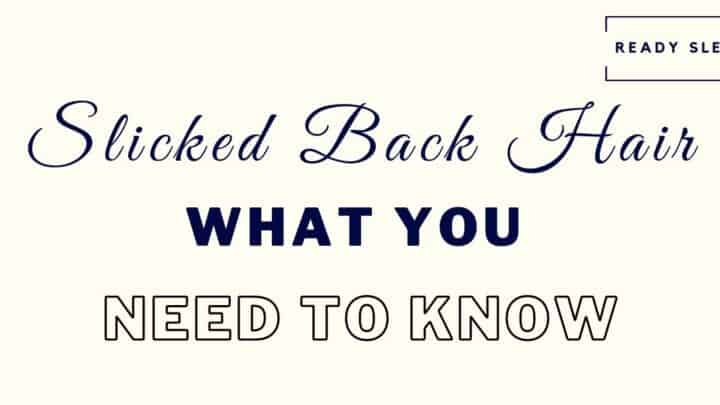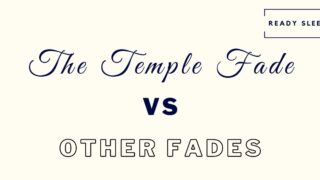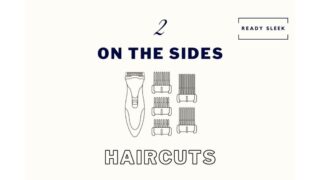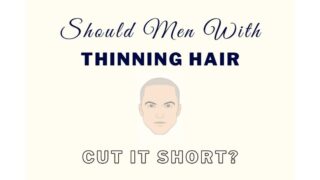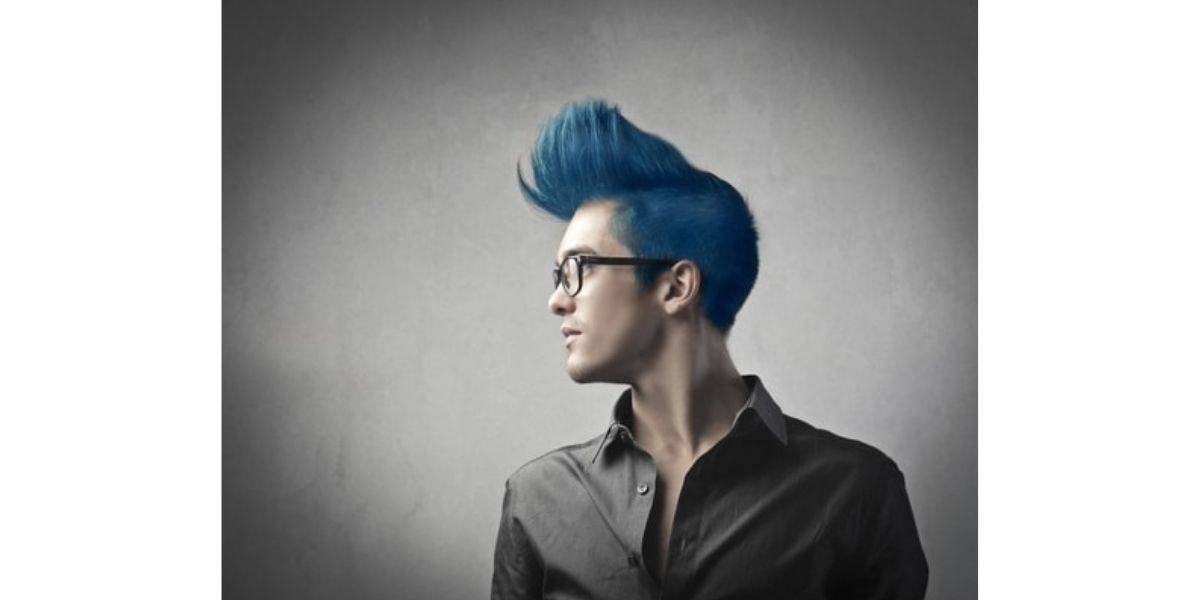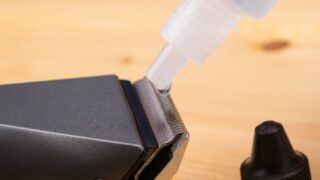It’s strange how a style so timeless, popular, and simple can cause so much frustration. You’re about to learn some crucial style tips and facts about the classic slicked back style.
Let’s get to it.
1. Is Slicked Back Hair Attractive?
Slicked back hair is undoubtedly attractive on many men due to its glossy definition and minimalist aesthetic. It is generally considered versatile and looks good on most face shapes except round ones.
Its simplicity is key to understanding why so many men (and women) are drawn toward slicked back hair.
There’s something very aesthetically pleasing when it comes to styles where there’s very little fuss and very few frills.
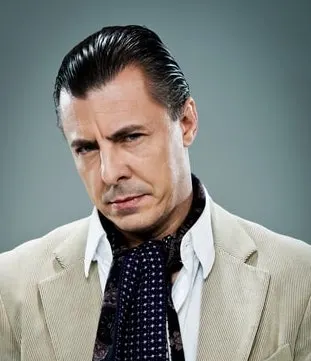
Minimalist styles are attractive to many.
It looks good on lots of face shapes. However, men with round faces should be more cautious when it comes to styling slicked back hair.
As the hair lies so flat against the scalp, there’s very little height or volume. As a result, it can exaggerate the shape of the face in the same way that baldness and buzz cuts can.
Here’s an article on baldness and face shapes if you want more information on this.
But ultimately, if you’ve got a round face and you flatten your hair with a slick back, it can exaggerate the shape of the face.
When you’ve got a round face, slick backs will most likely make it look even rounder.
Other face shapes can proceed with slick backs without much concern. It works well with most of them, including oval, oblong, heart, diamond, and even square.
Men that are self-conscious about a large forehead may also want to avoid slicked back hair. They may want to consider an alternative, fringed style such as a French Crop or Caesar cut.
But is slicked back hair in style?
Slicked back hair is still in style despite not being as popular as it was in the ‘50s and ‘60s. It has managed to stand the test of time, remaining relatively common in Western culture despite rapidly shifting trends in men’s style.
Vintage styles such as slick backs, comb overs, side parts, and pompadours do seem to be increasing in popularity. This is largely thanks to the ever-growing community of pomade aficionados on forums and social media.
2. What Does Slicked Back Hair Say About You?
Slicked back hair says that a man values his time, opting for a simple and minimalist style. It also says that he appreciates a more formal and defined aesthetic with a vintage edge – glossy and eye-catching but still subtle and understated.
At the end of the day, a slicked back style tells people that you don’t want to spend 10 minutes on your hair each morning.
A scoop of product and a minute of sweeping it all back is all you need. You usually don’t want to spend valuable time building layering, texture, or volume.
Just set it and forget it – that’s what you want.
Slicked back hair also says that a man values neatness. Not just neatness – but effortless neatness that doesn’t require constant preening, twisting, or tousling in front of a mirror throughout the course of the day.
This sort of neatness suggests efficiency and a no-nonsense approach to men’s grooming. There is very little fuss and very few frills and that’s just how they like it.
They also say that a man appreciates the hairstyles of days gone by. Slick backs have a long history and have often been associated with the rebels and nonconformists of the silver screen.
Styling a slick back is a great way for a man to show his appreciation for a golden era of men’s style.
3. Can Anyone Have Slicked Back Hair?
Not everyone can have slicked back hair. Men with hair that’s shorter than 3.5 to 4 inches will often have a lot of difficulty styling it as they won’t be able to keep the hair slicked back and in place.
Hair length is really the only factor that prevents a man from slicking back his hair. If you don’t have enough length, there’s really no point in trying to style it until you do.
In addition, men with very thick or coarse hair will also often find it tough to slick back their hair.
Again, this is due to the difficulty of keeping it slicked back against the grain for prolonged periods of time.
If you’ve got especially thick hair or hair that simply struggles to stay in place when slicked back, there are ways of training it over time to help it do so.
Here’s an article on training hair to slick back if you wanted more information on this. Headbands, hairnets, and spandex caps are all accessories that may be able to help with stubborn hair.
Men with thick hair would also be better off using a styling product with a stronger hold to really keep the hair in place throughout the course of the day.

But ultimately, if you’ve got hair that’s longer than approximately 3.5 to 4 inches long and your hair isn’t all that stubborn, you should be fine styling slick backs.
Whether the hair is thin, curly, wavy, or straight, it should be fine. If it isn’t fine now, it will be with some training over time.
4. Is Slicked Back Hair Professional?
Slicked back hair is universally considered professional due to its effortlessly formal and defined aesthetic. They are very often styled using shiny products such as pomades, gels, and waxes which do typically produce a professional-looking finish.
The fact that it’s so effortlessly neat and tidy is a key factor behind why it looks so professional.
Traditional slick backs are known for a shapely and defined finish where stray hairs and flyaways are flattened and side parts often emphasized.
“Unprofessional” hairstyles are usually either untidy or excessively attention-grabbing.
Although both of these factors are pretty subjective and will vary according to the industry and workplace we’re talking about, slicked back hair is extremely unlikely to be considered either of them.
It will never be considered untidy as it’s defined by tidiness.
It’s also very unlikely that it’ll be considered excessively attention-grabbing. Yes, it’s usually glossy due to the products used, but it is still pretty subtle and won’t draw much attention.
At the end of the day, slicked back hair will breeze through all but the most extreme dress codes with no trouble.
But here’s one we get a lot:
Can You Have Slicked Back Hair In The Army?
Slicked back hair may be approved in the army as it conforms to the natural shape of the head. However, given that it may be categorized as “eccentric directional flow”, some superiors may take issue with it.
5. What Product Is Best For Slicking Back Hair?
The products that are best for slicking back hair are oil-based pomades, water-based pomades, hair gels, and waxes. This is largely due to the glossy finish and medium to heavy hold that these products produce.
When it comes to slicking back hair, people often prefer using products that spread through the hair easily.
They don’t want resistance or grit as you may get with hair clay or putties.
For a traditional slicked back style where you want some definition and shine, you can choose between products with a gel-like consistency or a wax-like consistency.
Oil-based pomades are heavy, waxy products that usually have petroleum, petrolatum, or beeswax as a core ingredient. They’re known for having great, long-lasting shine, a pliable hold, and being tough to wash out.
Hair waxes are similar, but they’re less heavy, distribute a little easier, and are (usually) easier to wash out.
Products with a gel-like consistency are great because they will slick back like a breeze with very little resistance. They’re also usually water-soluble and so wash out very easily.
They include your straightforward hair gels which tend to get a bad rep due to flaking sometimes but there are some decent ones out there.
Water-based pomades are also a great product for slicked back hair – they have a gel-like consistency but usually don’t cause flaking.
Both hair gels and water-based pomades produce a stiff hold. This is great if you just want to set it and forget it, but not great if you want to restyle during the course of the day. You’ll need to soften it up with a bit of water first if you want to do so.
Although these products are the most commonly used ones for slick backs, you do have other options if you’d prefer a more textured or layered slick back.
If this is what you prefer, a more matte product such as hair clay or hair paste would be reasonable options. They may not be as popular for styling traditional slicked back styles, but if you’re going for a more modern, layered slick back, they’d both be suitable.
6. Can You Slick Back Thin And Fine Hair?
Thin and fine hair can be slicked back and is more likely to stay in place than fuller hair types. The main risk is that the typical shine and gloss of the slick back reveals too much of the scalp.
As long as you’ve got enough length (i.e more than around 3.5 to 4 inches), you should be able to slick it back without much trouble.
While thicker and coarser hair may react more stubbornly, refusing to stay in place, thin hair often plays ball. This is largely thanks to the lack of weight and resistance.
Two main risks with slicking back thin or fine hair:
One is that the typically “shiny” products used for styling slick backs such as pomades, waxes, and gels often aren’t ideal for men with thin hair.
This is because the shine often shows too much of the scalp and this can make thin hair look even thinner. It’s also because these products are known for their definition and not for building volume or texture.
That’s why men with thin or fine hair are usually better off going for more modern styles where layering and texture can be built with volume and fullness prioritized.
Matte or low-shine products such as clays, pastes, and putties would be better.
Another risk of men with thin or fine hair styling slick backs is that they often look very flat due to the low density of hair. This can exaggerate the face shape, just as a buzz cut would.
A solution to this would be to style a more modern slick back as opposed to a shiny and traditional one.
Using a more matte product (eg. clay or paste), style a messier, layered slick back where there’s more texture, volume, and fullness.
To sum that all up – yes, slick backs are fine for thin-haired men. Just be careful with the product you use and the type of slick back you style.
7. How Do You Add Volume To Slicked Back Hair?
Volume can be added to slicked back hair by using a thickening pre-styler, blow-drying from front to back, and using a volumizing styling product such as a clay or paste.
Slick backs aren’t known for their volume or fullness – they’re more about shine and definition.
But this isn’t ideal for a lot of men.
Men with thin hair may love the look of slicked back hair but don’t like the way the shine and flatness makes their hair look even thinner.
Adding some volume could be the solution.
It’s possible to add volume to slick backs but it does take a bit of work.
Pre-stylers come in handy here. As the name suggests, they’re products you apply before the actual styling. It’s often a good idea to apply them before blow-drying (if you plan on blow-drying).
There are different types of pre-stylers depending on what you want them to do. There are thickening and volumizing ones, and also smoothing ones.
Using something like a thickening tonic pre-styler would work well when trying to add volume to slicked back hair.
After applying it, blow-dry from front to back, using your fingers to lift and tousle the hair in the same direction.
This is a great way to add volume quickly in your desired direction. In this case, it’s backward.
Once this is done, it’s time for the post-styling, which is just another term for the “actual” styling.
If you’re looking to add volume, don’t use the typical pomades, waxes, or gels that are commonly used for styling slick backs. They’re simply too glossy and are difficult to build volume with.
Go for clays, pastes, or even creams – they’re great for building texture, fullness, and volume.
Ultimately, you’ve got options. Find one you enjoy and that works for you and stick with it.
8. What Brush Or Comb Should You Use For Slicked Back Hair?
For slicked back hair, the brush or comb you use depends on your hair type and the finish you want. When slicking back thick or long hair, a Vent brush or wide-tooth comb is best. When slicking back thin or short hair, fine-tooth combs are best.
Men with long, coarse, or thick hair often benefit from the bristles of a hairbrush.
They’re able to move through dense or long hair without much resistance. Wide-tooth combs can as well, although using them on long hair will take longer than using a hairbrush.
Denman Vent brushes are great for hair that isn’t especially stubborn. If your hair is prone to tangling, however, a paddle brush would most likely be better.
Men with thin hair are often better off going for a fine-tooth comb – you just have more control. In addition, the narrow spacing of the teeth leads to a very tight finish where there’s very little separation in between the strands.
This is great for thin-haired men where you don’t want much scalp showing through.
If you’d rather have a more layered look to the slick back where there is more spacing in between the strands (strand separation), go for a wide-tooth comb instead.
When it comes to strand separation and layering, Vent brushes fall somewhere in between. Not as much as wide-tooth combs, but more than fine-tooth combs.
To sum that all up:
- Thick/Coarse Hair: Wide-tooth comb or Vent brush
- Tangled Hair: Wide-tooth comb or Paddle brush
- Thin/Fine Hair: Fine-tooth comb or Vent brush
- Tight And Defined Slick Back: Fine-tooth comb or Vent Brush
- Layered And Separated Slick Back: Wide-tooth comb
9. Why Won’t My Hair Stay Slicked Back?
The most common reason for hair not staying slicked back is not having enough length. If the hair is less than 3.5 to 4 inches long it is unlikely to. In addition, thick hair often refuses to stay slicked back without training and the right product.
If you don’t have enough length, there’s really no point in even trying to style a slick back.
Measuring hair using a ruler can be a nuisance and a habit some men would rather not get into.
Although 3.5 to 4 inches is the average minimum length needed, an easy way to tell whether you probably have enough length is to pull your fringe straight down your face.
If it reaches a point beyond the bridge of your nose, there’s a good chance you have enough length.
Hair length is really the only thing that will prevent you from slicking it back.
If you’ve got enough length, most hair types will eventually stay slicked back with the right know-how.
Thick, coarse, and stubborn hair often refuses to stay in place even when you have enough length. That’s the problem with styling against the grain (i.e against the direction of growth) – you’re defying the laws of physics.
It may need to be trained to slick back over time – eventually, it should.
In addition, you’ll probably need a styling product with a heavier hold if you find that it’s being stubborn.
Medium/Heavy Hold Options:
- Shiny – Pomades and gels. Go for oil-based pomades if you want a pliable hold. Alternatively, go for a water-based pomade or hair gel if you want a stiff hold.
- Low Shine Or Matte – Hair clay or putties.
Although creams and pastes are great low-shine / matte options, they’re unlikely to give you the hold you need if your hair is stubborn or especially thick.
Clay is your best low shine option because it’s heavy and that characteristic grit helps it to maintain the structure of the style. Yes – this includes slick backs.
So, don’t fret.
If your hair simply isn’t long enough, just give it some more time. Side-slicked styles are often possible when the hair isn’t quite long enough to go for a full-on slick back.
If your hair is just stubborn and keeps flopping forward, you may not be using the right styling product.
10. What If The Slicked Back Hair Keeps Parting?
If slicked back hair keeps parting or splitting in the middle, it may be too long. Trim it short enough to prevent the weight of the hair causing this to happen, while still keeping it long enough to slick back.
Remember, the minimum length for slicking back is usually around 3.5 to 4 inches. Any shorter than this you’ll struggle to keep it slicked back.
But when hair is too long for your hair type – particularly when the hair is thin or fine – it often parts or splits. This frequently occurs in the middle, leading to a curtain-like appearance.
So, try trimming it a bit shorter to see if it fixes the problem. As long as you keep it above the minimum length, you should be fine.
Another way of preventing slicked back hair from parting is to use a product with a stronger hold.
Products such as pomades and hair gels are often useful in this respect. However, when you’re looking to stop the slick back from parting, a stiff hold would be better than a pliable hold.
This may not be ideal as pliable holds are great in many ways. But when the style is pliable (like with an oil-based pomade or hair wax) it’s more likely to fall out of place and into that parted position when you (often accidentally) run your fingers through it during the day.
The stiff hold of a hair gel or water-based pomade would stop this from happening.
Applying the product to dry hair as opposed to wet hair is also better when you’re trying to stop the slick back from parting or splitting.
When drying the hair, blow-drying backward at an angle (i.e not straight back) to one side or the other is another good way of preventing the hair from parting.
It almost creates a “comb over” appearance as opposed to a traditional slick back. But it’s a good way of stopping the hair from parting or splitting.
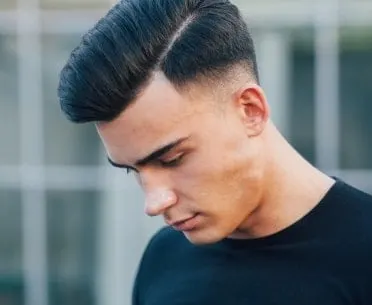
[From Shutterstock]
11. Can You Slick Back Hair With A Cowlick?
Hair can be slicked back with a cowlick by growing it long enough to cover the cowlick at the back. When slicking back shorter hair, a cowlick will need to be flattened in the directions it grows to prevent the slick back from sticking up at the back.
Although cowlicks can crop up anywhere, the most common areas are the crown, the base near the neck, and the front.
When slicking back hair, the most common issue is the swirled cowlick at the crown causing the hair to stick up and outward at the back.
The simplest (although not the quickest) solution would be to grow the hair longer. It should be long enough to slick it all the way back and over the cowlick at the crown.
This is a great way of covering up the cowlick when styling slicked back hair.
But if your hair isn’t long enough to do this, you’ll need to work with the cowlick to stop the hair from sticking up here.
So, before styling your slick back, comb the hair immediately around the cowlick, flattening it in the many directions it grows in.
Although this won’t cover up the cowlick, it should still prevent the hair from sticking out here once you’ve styled your slick back.
One way of (potentially) covering up the cowlick even when your hair isn’t quite long enough is to use a heavier product when styling the slick back.
The weight of the hair at the back may be enough to just about cover up the cowlick when slicking it all back. Pomades are a good option. But ultimately, you’ll still need enough length for this option too.
Conclusion
There you have it. Answers to some slick back style questions that are frequently asked but rarely answered properly.
Hope you found it useful.
It’s a style that appeals to so many men and for good reason. Simple, stylish, and timeless.
Enjoy.
Ready Sleek founder. Obsessed with casual style and the minimalist approach to building a highly functional wardrobe. Also a fan of classic, vintage hairstyles.

